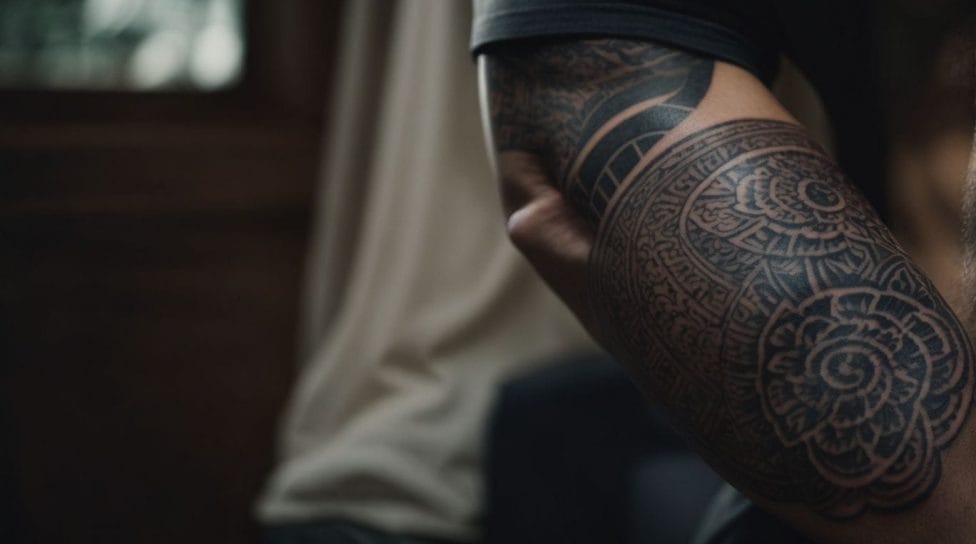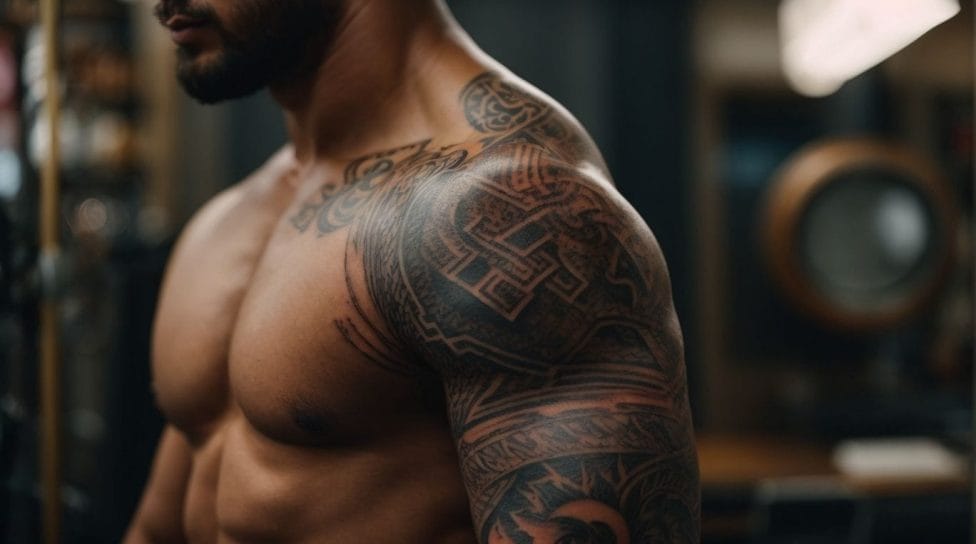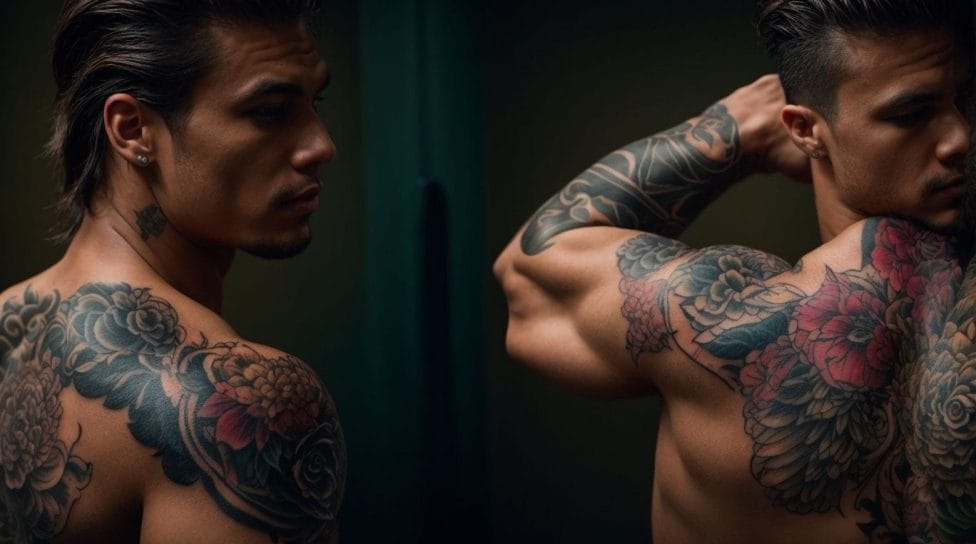When it comes to tattoos and muscle gain, many individuals wonder if their tattoos will stretch or distort as their muscles grow. To understand the relationship between tattoos and muscle gain, it is essential first to comprehend the structure of tattoos and how they interact with the skin. Tattoos consist of ink injected into the middle layer of the skin, known as the dermis, which provides stability and longevity to the design. This leads to the question: can tattoos stretch when you gain muscle?
In exploring the impact of muscle growth on tattoos, it is important to note that the skin is a highly elastic organ that can expand and contract to accommodate changes in body shape. Therefore, as muscle mass increases, the skin expands alongside it. While tattoos may undergo some changes during this process, such as slight distortion or stretching, it is important to understand that these changes are usually minimal and can vary depending on various factors.
Factors that can influence tattoo stretching include the placement of the tattoo on the body, the design and size of the tattoo, and the elasticity of the skin. Tattoos on areas prone to significant muscle growth, such as the biceps or thighs, may be more susceptible to stretching. Similarly, larger and more complex designs may show more noticeable changes during muscle gain.
To preserve the appearance of tattoos during muscle gain, there are a few tips to consider. Proper placement considerations, such as avoiding areas prone to stretching, can help minimize the impact of muscle growth on the tattoo. Consistent moisturization and skincare can also maintain the skin’s elasticity and prevent excessive stretching. Practicing gradual and controlled muscle growth can help reduce the strain on the tattooed skin.
While these tips can help mitigate potential changes, it is always recommended to consult a professional tattoo artist or dermatologist for personalized advice. They can provide insights based on the specific tattoo and individual circumstances, ensuring the preservation of the tattoo’s appearance while achieving the desired muscle gain.
Key takeaways:
- Tattoos can stretch when you gain muscle: The skin stretches when muscle growth occurs, which can cause tattoos to stretch and distort the shape.
- Tattoo placement is an important factor: The location of the tattoo on the body can determine how much it stretches with muscle gain. Areas with more elastic skin, like the upper arm, may be less affected.
- Taking care of your skin can help preserve your tattoo: Consistent moisturization, skincare, and gradual muscle growth can help minimize the stretching and distortion of tattoos when gaining muscle.
Understanding the Structure of Tattoos

Photo Credits: Tattooineplanet.Com by Brandon Jackson
Understanding the structure of tattoos is crucial in determining their resilience and potential changes. Tattoos comprise ink particles injected into the dermis, which is the second layer of skin. The dermis consists of collagen fibers that provide stability and strength. While gaining muscle, the size of the muscle increases, yet the dermis remains comparatively stable. Excessive muscle growth or weight gain can stretch the dermis, resulting in the distortion of the tattoo. Fluctuations in weight can also induce alterations in the appearance of tattoos. Effective placement, appropriate size, and proficient tattooing techniques can minimize the impact of stretching on tattoos.
What Are Tattoos Made Of?
Tattoos are made of ink injected into the dermis layer of the skin. The ink consists of pigments suspended in a carrier solution, which helps deliver the color to the skin. The most common pigments in tattoo inks are carbon black, iron oxide, and titanium dioxide. Some inks may also contain additives like glycerin or alcohol to help with application. The composition of tattoo inks can vary depending on the brand and color. It’s important to note that tattoo inks are regulated by health authorities to ensure safety and minimize risks of adverse reactions.
What Are Tattoos Made Of?
How Do Tattoos Work?
How Do Tattoos Work?
Tattoos work by injecting ink into the dermis layer of the skin using small needles. The needles puncture the skin and deposit ink droplets, which are then absorbed by the cells and become permanent. The reason tattoos stay in place is that the ink particles are too large for the body’s immune system to remove. Over time, the ink may fade slightly as the skin naturally exfoliates, but the tattoo remains visible. Taking proper care of your tattoo, such as moisturizing and protecting it from the sun, can help maintain its appearance and prevent fading.
Can Tattoos Stretch When You Gain Muscle?

Photo Credits: Tattooineplanet.Com by Gerald Flores
When it comes to gaining muscle, many tattoo enthusiasts wonder if their ink will stretch along their muscles. In this section, we’ll dig into the fascinating world of how tattoos and muscle growth intersect. Discover how muscle gain can impact tattoos as we explore the effects and potential concerns that arise when ink meets muscle. So, let’s dive in and untangle the intricate relationship between muscle growth and the preservation of tattoo art.
Exploring the Impact of Muscle Growth on Tattoos
Exploring the Impact of Muscle Growth on Tattoos
Muscle growth can have a significant impact on tattoos. As muscles expand, the skin stretches, potentially leading to the distortion or diminished definition of a tattoo. The degree of stretching depends on various factors, including the placement, design, and size of the tattoo. However, areas of the body with higher elasticity, such as the upper arms and thighs, may experience less distortion. To preserve the appearance of tattoos, it is important to ensure proper placement and gradual muscle growth. Additionally, consistent moisturization and skincare play a vital role. Consulting a professional tattoo artist can provide valuable advice on placement and care during muscle gain.
The impact of muscle growth on tattoos can be traced back to ancient times when tattoos were often associated with strength and masculinity. Warriors of that era would decorate their bodies with tattoos, symbolizing their prowess in battle. As these warriors underwent rigorous training and gained muscle, their tattoos would stretch and adapt to the changes in their physique. This tradition continues in modern times, with bodybuilders and athletes proudly displaying their tattoos as a testament to their hard work and unwavering dedication. Despite the potential for stretching, tattoos remain a powerful means of self-expression, capable of evolving with the individual at every stage of their muscular journey.
Factors That Influence Tattoo Stretching

Photo Credits: Tattooineplanet.Com by Dennis Ramirez
Tattoos and muscles are an intriguing combination! Let’s dive into the fascinating world of tattoo stretching and explore the factors that come into play. From the tattoo’s placement to its design and size, as well as the unique elasticity of the skin, we’ll uncover the secrets behind how tattoos may adapt and evolve along with your muscular gains. So, if you’re curious to understand the dynamics between ink and brawn, this is the section for you!
Tattoo Placement
When deciding on tattoo placement, it is crucial to consider various factors. The placement you choose can impact the visibility, longevity, and overall appearance of your tattoo.
- Visibility: It’s essential to think about whether you want your tattoo to be easily seen or if you prefer a more discreet placement. Many individuals choose highly visible areas like the arms, legs, or neck to showcase their tattoos.
- Longevity: Remember that certain body parts are more prone to stretching and the effects of aging, which may affect how your tattoo looks over time. Areas with more elastic skin, such as the stomach or inner arm, may be less likely to stretch and distort the tattoo design.
- Design suitability: Different body areas may suit certain tattoo designs. For instance, smaller and more intricate designs may look better on the wrist or ankle, while larger designs may be more fitting for areas with more space, like the back or chest.
- Pain tolerance: It’s important to consider that different parts of the body have varying levels of sensitivity and pain tolerance. Before deciding on tattoo placement, think about how much discomfort you are willing to endure.
Tattoo Design and Size
Regarding tattoo design and size, there are several factors to consider.
- Placement: Selecting a suitable area on your body that can accommodate the size and intricacy of your chosen design is crucial.
- Design: The level of complexity and detail in your tattoo can greatly influence its longevity and how it may stretch over time.
- Size: Larger tattoos carry a higher risk of stretching and distorting, especially if they are placed in areas prone to weight gain or muscle growth.
- Title of External Link: Do Tattoos Stretch When You Gain Muscle?
To maintain the appearance of your tattoo during muscle gain, it is imperative to seek advice from a professional tattoo artist who can provide tailored guidance for your specific situation. They can assist you in choosing the right placement, design options, and aftercare routines to minimize any potential stretching or distortion.
Elasticity of the Skin
The elasticity of the skin is a crucial determinant in tattoo stretching. The skin’s ability to stretch and rebound to its initial form directly impacts the visual aspect of a tattoo as muscles develop or contract. Several factors, including age, genetics, and overall skin health, influence skin elasticity. Maintaining skin elasticity and safeguarding the integrity of tattoos during muscle gain can be achieved through proper skincare practices such as moisturization and sun protection. Moreover, controlled and gradual muscle growth can also mitigate the stretching impact on tattoos. Seeking advice from a professional tattoo artist or dermatologist can offer valuable insights on preserving the appearance of tattoos during muscle gain. Furthermore, it is essential to prioritize the health of your skin while pursuing your fitness goals.
Tips for Preserving Tattoo Appearance During Muscle Gain

Photo Credits: Tattooineplanet.Com by Nathan Adams
Maintaining the appearance of your tattoo during muscle gain is crucial if you want to showcase your ink with confidence. In this section, we’ll explore practical tips to help you preserve the integrity of your tattoo as you sculpt your physique. From considering proper placement to practicing consistent moisturization and skincare, we’ll cover essential aspects to keep your tattoo looking its best. We’ll delve into the importance of gradual and controlled muscle growth to minimize potential stretching and distortion. Let’s ensure your tattoo remains a stunning work of art throughout your fitness journey.
Proper Placement Considerations
When considering proper placement for tattoos, it is essential to consider various factors such as body movement, visibility, and potential stretching.
| Proper Placement Considerations | Consider areas of the body that experience less movement, like the upper arm or back, to minimize the risk of distortion. |
| Proper Placement Considerations | Choose a location that aligns with your preferences and the level of visibility you desire, whether a more private or public area. |
| Proper Placement Considerations | Avoid areas prone to significant changes in size, such as the abdomen or thighs, as muscle gain or weight fluctuations could distort over time. |
These proper placement considerations can help preserve the design and appearance of your tattoo as you engage in muscle gain or other physical changes.
A friend of mine carefully chose the placement of her tattoo on her upper back to maintain its integrity despite her dedication to weightlifting. She did thorough research and consulted with a professional tattoo artist, ultimately leading to a stunning and well-preserved tattoo even as she achieved her muscle gain goals.
Consistent Moisturization and Skincare
- Consistent moisturization and skin care are essential for maintaining the appearance of tattoos during muscle gain. Here are some helpful tips to follow:
- Ensure your skin stays hydrated by regularly applying a tattoo-friendly moisturizer.
- Avoid overexposure of your tattoo to sunlight, as UV rays can cause color fading.
- Every day, gently cleanse your tattooed skin using a mild, fragrance-free soap.
- Shield your tattoo from harsh chemicals, like chlorine, in swimming pools by covering it with a waterproof bandage.
- To promote proper healing and reduce the risk of infection, diligently adhere to any aftercare instructions provided by your tattoo artist.
In ancient Egypt, skincare and moisturization were held in high regard. Egyptians used natural ingredients like olive oil, aloe vera, and honey to nourish and hydrate their skin. They strongly believed that healthy skin was not only visually appealing but also indicative of good health and prosperity. These skincare rituals were passed down from one generation to the next, underscoring the significance of consistently moisturizing and caring for the skin throughout history.
Gradual and Controlled Muscle Growth
Maintaining gradual and controlled muscle growth is imperative to preserve tattoo appearance. To achieve this, follow these steps:
- Establish realistic goals for muscle gain to prevent rapid expansion.
- Seek guidance from a fitness professional to develop a customized workout and nutrition plan.
- Avoid sudden weight gain, as it can result in skin stretching and distortion of the tattoo.
- Emphasize progressive overload and consistent strength training to stimulate muscle growth.
- Prioritize hydration to keep the skin supple and prevent dryness.
- Ensure adequate rest and recovery to optimize muscle development.
A close associate of mine encountered tattoo distortion due to rapid muscle gain. To rectify the distorted design, they consulted a tattoo artist who proposed incorporating the stretched areas into a larger, more intricate tattoo. This incident highlights the significance of gradual and controlled muscle growth in maintaining the quality of tattoos.
Consulting a Professional for Advice

Photo Credits: Tattooineplanet.Com by Adam Davis
When considering the impact of gaining muscle on tattoos, it is crucial to consult a professional for advice. Seeking guidance from a knowledgeable tattoo artist or dermatologist who can assess the individual circumstances is highly recommended. They can evaluate the location, size, and design of the tattoo to determine how it may respond to muscle gain. In addition, they can provide valuable tips and instructions on proper care and maintenance, minimizing the risk of stretching or distortion. By consulting a professional for advice, individuals can make well-informed decisions and effectively preserve the integrity of their tattoos.
Some Facts About Do Tattoos Stretch When You Gain Muscle?
- ✅ Tattoos are permanent unless you opt for laser removal.
- ✅ Consider the placement and design of a tattoo about changes in muscle tone and size.
- ✅ Body mass accumulation is unlikely to stretch out a tattoo, except in areas prone to stretch marks.
- ✅ A few inches of muscle bulk difference may be noticeable, but it won’t significantly affect the appearance of a tattoo.
- ✅ Tattoo stretching may occur if muscle mass increases significantly, causing damage to the design and ink.


